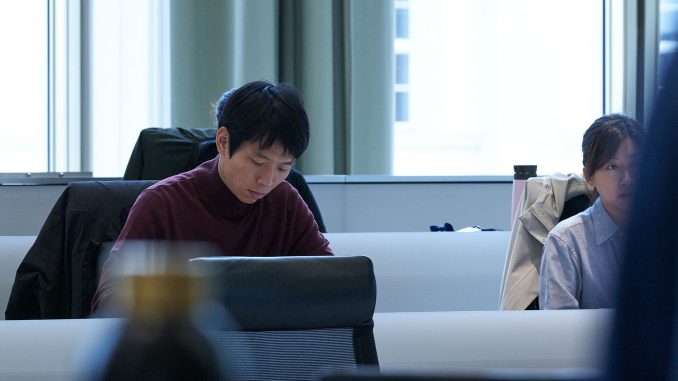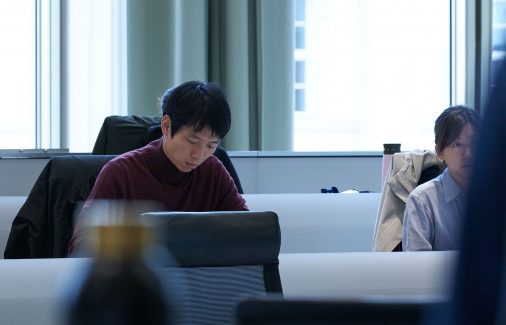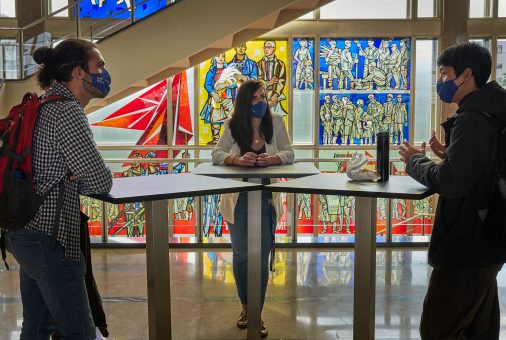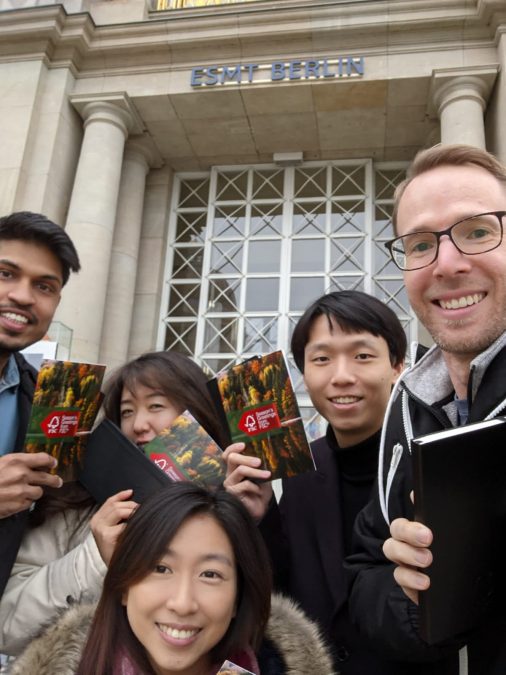

Before studying at ESMT Berlin, Shangyuan Chen received his bachelor’s degree in finance from the Anderson School of Management at the University of New Mexico and his Master of Accounting from the University of North Carolina at Chapel Hill, both in the US. He then started his career in the real estate and financial sectors in China, before he began his Full-time MBA studies at ESMT in 2020. Shangyuan recently graduated from ESMT and we caught up with him to gain an insight into his MBA experience and life after graduation.
Having studied in both the US and Germany, how would you compare those experiences?
Generally speaking, my experiences were quite different during these two periods. The first thing that comes to mind is the difference between two words: Diversity and decentralization. The US schools showed diversity, while ESMT gave me a decentralized experience.
In terms of students, at the two US business schools I attended, American students accounted for about 70-90% of the student population. The diversity I felt at US universities usually referred to African American, Asian American, Hispanic American, female American, and so on, who were raised within the US education system. They shared a common ideology and viewed the outside world mostly from a US perspective.
International students need to try to understand the United States and try to fit in with the local culture, such as going to American football games. Of course, most business schools around the world are likely to have mainly local students and there is nothing wrong with that. But when I came to ESMT, there were only two German students in our class of 48 and because the language of instruction is English, they spoke to us in their second language with a foreign accent, which made it feel like everyone was an international student. I was able to get to know the German culture and many other cultures in parallel.
Students at ESMT are not only from different countries and industries, but most of them have studied or worked in more than one country and speak a third or additional languages. They can introduce the culture and business environment specific to the countries they represent, as well as ideas and thoughts based on their international perspective on top of their understanding and acceptance of diverse cultures.
The US or German perspective is only one of many. Moreover, I felt that Chinese students were often the largest group of international students in the US universities, and being in this “second center”, we often had relatively less interaction with other international students.
In the decentralized environment at ESMT, it was very interesting to listen to students talk about their work, study, and life experiences in class, between classes, and during lunch every day. It was a daily activity for me to get to know each individual, each with a part that represents their own cultural background and a personal characteristic that is different from those who come from the same country. I think this decentralized environment allows students to reduce preconceptions about a particular country in our business analysis, to understand business from their perspective, and to make better decisions.

In terms of faculty and content, when I studied in the US, most of the faculty were American, and almost all the cases I studied were US companies and finance based on the US stock market. They rarely discussed how a company would do business between Europe and Asia, or how the political and cultural environment in Europe would affect the operations and management of African companies.
ESMT, on the other hand, has a much richer source of faculty from many different countries, who often bring in cases from their own countries. Of course, many of the courses also use cases from Harvard or other US business schools, which is where the MBA education originated, but we also studied cases from other business contexts and ‘non-US’ perspectives on management.
When I was in my early 20’s in the US, I thought I had seen the world and I thought I knew enough about China after working there for many years. However, there was still a big gap between my knowledge of internationalization and globalization.
On the one hand, I didn’t know enough. For the first time, I heard professors mention the Romanian stock index, the Ecuadorian microfinance, the case of Napoleon about team management, and the case of Magellan about ethics. When a German professor used the case of a famous Chinese company for a discussion, I could not contribute to the discussion from a Chinese student’s perspective because I didn’t know about the company. I realized then that I needed to broaden my horizons and go beyond the China-US-only view.
On the other hand, I didn’t reflect enough. Thinking about the logic behind the same issue (e.g., the trade war between China and the United States) from the perspectives of professors from different countries or backgrounds, or seeing the practice of waste management in a certain region in India and thinking that it might be more relevant to China at this stage than the “advanced methods” in Europe, US, and Japan, I realized that I needed to learn more and reflect more on globalization, and even on China and the US.
Another area where I noticed a difference was on the topic of sustainability. While both sides address it, I feel that it is more common and intense in Europe. I see a lot of people cycling to and from work on the streets of Berlin whereas, well, I don’t have to say how cars are used in the US. At ESMT, many of the students come from this background and more of them want to go in this direction after graduation, and it is always covered in the discussions in class.
A similar daily routine can be found at the school, where the enthusiastic information center manager sends out weekly information on sustainability and every student club has a clear outline of sustainability. In addition, ESMT has a dedicated Centre for Sustainable Business and Leadership, which holds regular roundtable discussions with organizations specializing in sustainability and with managers of sustainability departments from various companies. I attended last year’s roundtable and it was very rewarding.
My undergraduate degree and Master of Accounting were both in business and while sustainability was a mandatory part of many of the courses, it was left for the last session towards the end of the course. In many of the ESMT courses, sustainability is brought up many times and integrated into the course content. Some of the professors at ESMT even use sustainability as the main idea in the first lesson and then discuss business aspects based on this core idea in the rest of the lectures. I think this is very different from just saying “sustainability is important” during the discussion of business content.
After graduating from your MBA, you began ESMT’s Responsible Leaders Fellowship (RLF) program, can you tell us about the program?
Sure! The RLF is a post-MBA program offered by ESMT, usually four to six months in length, where MBA graduates can contribute their knowledge and talents to create value for projects in developing countries on a variety of topics. These projects are led by the fellows in collaboration with local non-profit organizations or NGOs, and the project proposal is finalized and submitted to the school for approval. The fellows do not benefit financially from the project but do not have to worry about the costs of travel and living expenses, which are supported by the Friends of ESMT (ESMT’s community of friends and sponsors).
Towards the end of the ESMT MBA program, there is a Consulting Project for around eight weeks, in which students work in teams of four to six people to provide consulting services to real companies, resulting in a final report or thesis. Of the nearly 20 consulting projects available this year, I took part in a project offered by the Forest Stewardship Council (FSC) to consult on a strategy and implementation plan to improve the sustainable management of rubber forests and the livelihoods of smallholder farmers in Indonesia through FSC certification.
I benefited from this Consulting Project which was a real eye-opener for me as I had never worked with a non-profit organization before. I had the opportunity to discuss solutions online with rubber value chain stakeholders and other NGOs from Southeast Asia and other parts of the world, and to experience the pros and cons of globalization.
The content of the project was also a good fit for the future direction of agriculture that I want to pursue. Therefore, everything suggested that continuing this project would be a good choice, which is why I decided to do so through the RLF program with the same topic, but in Thailand.
This year, due to the pandemic, the RLF accepted 3-month remote projects, therefore I am participating remotely from Berlin and hope to have the opportunity to visit Indonesia and Thailand once the pandemic is under control. I would like to thank our MBA alumni, Bin Yan and Sean Nyquist, who accepted the RLF project and the previous Consulting Project on behalf of the FSC. I am hoping to change my career to an agriculture-related industry through this MBA, so the whole process of the Consulting Project plus the RLF was extremely helpful in terms of career development.
Choosing to quit your job to do a full-time MBA after working for a while was a decision that required a trade-off. How did you make the decision and measure the return on investment (ROI) of the MBA? And how would you evaluate what you gained from your year at ESMT?
Interesting question! Well, although my undergraduate and Master of Accounting were both finance-related and I worked in the financial sector before my MBA, I don’t really recommend using ROI to calculate and decide whether to do an MBA or which school to choose.
For me, ROI is a pure investment concept which is usually an indicator used when the investors are not involved in management and the returns and costs are clear figures. Doing an MBA is more like entrepreneurship for me; the outcome depends largely on the entrepreneur her/himself and there are too many returns that cannot be quantified, which depend on what you have experienced in the past, how you define value and meaning, and how hard you work and explore in the process.
For prospective candidates, I recommend that you work out a learning method that’s best suited for you and allow yourself to improve the returns, rather than looking at the numbers on the school’s ranking list.
My year at ESMT made a lifelong impact on me: I want to see myself in the field of agricultural technology in the next decade. Of course, it wasn’t so easy to make this decision. Initially, it was only a simple idea, a very uncertain one at that. But during the year at ESMT, the path has been made clearer and my will has become stronger.
For example, I am a co-founder of ESMT’s Agriculture Technology Club, which aims to actively help the innovation of agriculture technology by exploring the application of emerging technologies in customized products and services for agriculture.

We went on field trips, visited Gut&Bösel where Benedikt Bösel, head of the German AgTech Platform, presented his current projects on sustainable farming. We also organized a variety of activities such as workshops and networking with companies such as Bayer Crop Science and Bosch (who provide equipment and services that use AI to predict the occurrence of pests and diseases in crops). Many other activities were planned but were unfortunately delayed due to the pandemic, such as building a greenhouse on campus to test the equipment and a tree-planting trip was to be hosted by Bergwaldprojekt.
For the Global Network for Advanced Management (GNAM) Week, I chose the Inclusive Business Model course at the Indian Institute of Management Bangalore (IIMB), which was about how for-profit companies can embrace people living in poverty in the business processes and improve their livelihood through innovative profit model while generating profits for the business. The course used a wide range of applications in education, healthcare, infrastructure, and agriculture, especially in rural areas. This showed me how things that are usually done by non-profit organizations, can be done by for-profit companies in ways that non-profits may not think of.
As I mentioned earlier, I was involved in a project on the natural rubber industry as part of my pre-graduation Consulting Project, gaining relevant experience in agricultural-related supply chain and solidifying my choice. I hope to gain a deeper understanding of the industry and further clarify my plans in the RLF project.
I would like to thank the Career Coach that the ESMT provided, which is different from the Career Services team. The Career Services team at the school focuses on helping students by organizing career fairs and workshops, revising your CV, providing job information, etc. But a Career Coach does not help with a specific task, they guide us to find our future direction.
I use the word “guide” because she doesn’t tell me what to do, but rather she inspires me to think in a way that I can find the answers myself. My coach has really helped me a lot. When I chose to venture into a completely new industry, I was anxious and had doubts. Throughout the process, she listened patiently, asked me questions based on my background, and encouraged me to try and practice through the process of finding answers and refining my goals and plans.
ESMT has provided me with so many resources and platforms to reevaluate my plans for the next 5-10 years and to be more prepared for the uncertainty of the future, the returns cannot be summarized into a specific number for ROI calculation.
It is often easy to compare the economic numbers, but how to interpret these numbers requires avoiding some misconceptions. For example, when I was applying for the MBA, I saw some sources that used the average annual salary of graduates as a return value to assess and compare schools. There can be three problems with this. First, history does not necessarily reflect future returns. Second, the average annual salary figure does not include those students who have chosen to start their own businesses. Third, many students who have gone into social services or sustainable development have created significant self-value, social and environmental value, and salaries in these sectors are usually lower.
This reminds me of the GNAM course. Many business graduates have experienced the difference between the ideal and the reality and as the “bubble” of merely pursuing bigger and more profitable businesses comes to an end, the Inclusive Business Model offers a lot of room for business. Most of the cases are not about non-profit or charity, they are just not pursuing “profit maximization” or “shareholders’ value maximization” as the goal of enterprise development. This is very interesting and shows that much of what you learn at business school can be put to good use.
Furthermore, the surrounding environment comes with the choice of school. For example, ESMT and UNC are both excellent schools with similar faculty quality and talented students, but Berlin and Chapel Hill are completely different worlds where people care about different things and think differently, and the impact on each MBA student is different. Both schools provided a great number of talents, contributing to their respective professional fields and geographical areas that cannot be measured by ROI. Therefore, the inspiration from the environment also constitutes part of the future returns that cannot be quantified.
I would recommend future candidates to start with yourself, carefully review your experience, reflect on your limitations, consider what kind of changes and growth you wish to obtain through the MBA experience, and take the initiative to pursue, instead of passively considering how much ROI the MBA can bring you.
Agriculture doesn’t seem to be one of the most sought-after industries for MBA graduates, so why did you choose this direction?
When I was looking for a job after graduating from North Carolina, I gave priority to the more popular industries. And that’s normal. For students who have never been in the workplace before, it’s not very clear what they really want, and making enough money to support themselves is the priority. However, after working for a while and accumulating some experience and capital, your ideas can change and you might think more about what you really want to do in the future.
You said that agriculture does not seem to be the kind of industry that is sought after by MBA graduates, and the reason is obvious: money comes slowly in agriculture. I remember the time I visited a vineyard in Burgundy, the local farmer said, “We haven’t had good sunshine for three years here, there were too many rainy days and the wine is not good, but we don’t think God will be so unfair to us, the next three years should be good.” That’s when I realized that farmers have such a different concept of time from those who work in finance. We are talking about six years duration and the success is dependent on uncertain weather.
If you see this kind of time and riskiness in a project, few investors will give a second look, so passion is the most important driver. I grew up in the mountainous area of northern Fujian Province and I always feel close to nature, but I never thought of a career path in this direction. It was only a few years ago, when I took the WSET certification for job-related purposes, that I became interested in viticulture. I was fascinated by the way grape farmers try to improve grape varieties, enhance flavors, and increase yields while following the laws of nature and using sustainable methods.
On another occasion, I joined an agricultural field study trip to Taiwan to see great farming and management practices, which I found particularly interesting. Later on, when discussing cultural tourism projects with my partner, the agricultural element was also a point of continuous interest to us. When I came to ESMT, I found that many of my MBA classmates had worked in popular industries before focusing on sustainability and wanted to make the transition through the MBA. While working on the FSC project, I was very happy to find out that a forest area in my hometown had just been certified as an ecosystem services forest by the FSC. There are many more of these types of experiences that have supported my interest in agriculture.
The “T” in ESMT stands for technology and the school is exceptional in this area. For example, starting in 2016, ESMT became the first business school in Germany and one of the first in the world to start accepting Bitcoin for tuition payments. Part of our curriculum exposed me, a guy who knows nothing about coding, to programming languages.
The goal of the MBA is to train business executives or entrepreneurs and having this group learn relevant programming to empower their data analysis skills can help to open up some of their blind spots in thinking, helping to reduce communication barriers with programmers in the future. After attending these classes and talking to my classmates, I also started to think more about the application of these technologies in agriculture and exploring more possibilities for agriculture.
For example, recently I attended a webinar about “future agriculture” – AI and bio-info analysis, which involves the application of supervised/unsupervised learning, cluster analysis, machine learning, deep learning, neural nets, etc. in the future of agriculture practices. I was so glad that I took the Analytics Track during the MBA, which helped me to get a basic understanding of all of these terms and the possible applications of these methods so that I could partly follow up with such a technical talk, which I couldn’t possibly have understood before the MBA.
Everyone has different experiences and different expectations of an MBA. For me, I wanted to explore new possibilities in other industries through my MBA, which I had little idea about before I came here, but now it has become much clearer. The experiences in New Mexico, North Carolina, and China have been very valuable, providing a lot of contexts for thinking about my future direction. On top of that, the ESMT experience has further opened up many blind spots in my consciousness that I think will last a lifetime. I can’t predict what the future holds, but I have the confidence and patience to explore, and will strive to create new possibilities.
